Keir Leslie – 25 March, 2014
It might be said he is interested in the tricks of the trade, in exposing but also delighting in them. Sometimes de Vries makes his processes and methods very clear and sometimes he uses sleight of hand and of eye to disguise them.
The punning, allusive pattern of the title flows through Tjalling de Vries‘ latest Christchurch show. The conceit (and conceit is an apt phrase for this exhibition) referred to is that the canvasses presented are scaled-up copies of small, playful compositional studies executed on card. This process is made visible by the choice to show one of those studies alongside the resulting scaled up effort, an exposure of the underlying way of working.
The resulting paintings are large. Most are on linen, with large expanses left bare, but two are painted on polyethylene, clear plastic revealing the underlying cedar stretchers. The blank spaces are littered with a collection of motifs gleaned from the detritus of the studio: the fringe of paint left behind on a surface when a work is taken away, rough pencil lines, the ghost images of masked out areas, cartoon figures, and scribbled loops of paint. The deliberate informality of the motif, and the seemingly slapdash compositions, are belied by the subtle but clear pointers to the precise and contemplative method used to arrive at this result.
For de Vries, painting is a technical process, a deliberate, skilled craft of placing pigment onto support. Clearly, this is a technical process he has a certain amount of mastery over, but one he is still fascinated by. It might be said he is interested in the tricks of the trade, in exposing but also delighting in them. Sometimes de Vries makes his processes and methods very clear and sometimes he uses sleight of hand and of eye to disguise them.
A step into this visible treatment of painting as a technical process is the grid. There are two physically underlying grids in most paintings: the grid of the stretcher, and the weave of the support. These are normally obscured by paint and fabric in the finished painting but de Vries makes them visible. He does this by leaving the support bare, by using a transparent support, and by propping up the paintings in such a way as to render the reverse visible. These grids, matrixes that arise simply from the material structuring of the object, are allowed to proceed into the image in order, it seems, to present a sort of naked truth about the art object.
Yet contrarily, he carefully constructs these images as fiction. The paintings often recall collage, but are resolutely flat, resolutely painted. They often appear spontaneous, but as the smaller compositions reveal, are carefully considered. It is through these contradictions, through these tricks of the trade, that de Vries evidences a complicated project of investigation into the visual complicity of painting.
And if we return to the grid, we see that besides functioning as a bare fact, it is also a sophisticated compositional strategy drawn from the canons of modernist exploration that de Vries has been schooled in. Seemingly off-hand, but coming from a painter who made his name with precisely gridded explorations of the self, it begins to suggest that this body of work is also autobiographical in a sense - a portrait of a practice.
Keir Leslie
Recent Comments
Michael Collins
The scaling up process was one of many engaging aspects about "Copy Card." I enjoyed the the front to back ...
Roger Boyce
Hey Mr. Hurrell, I don't see my comment demonstrating, what you've called, "differences with Mr. Leslie" himself. Nor do I ...
John Hurrell
Hey Mr. Boyce, where's the democracy here? This is a forum, and if you have differences with Mr. Leslie, keep ...
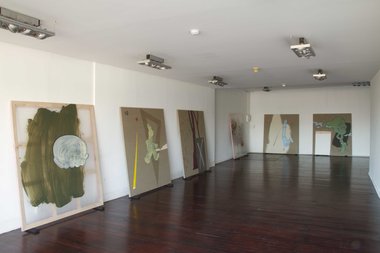


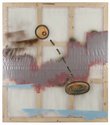
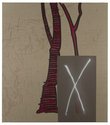
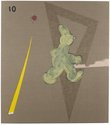

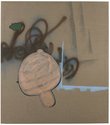

 Advertising in this column
Advertising in this column Two Rooms presents a program of residencies and projects
Two Rooms presents a program of residencies and projects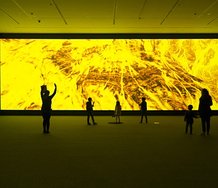
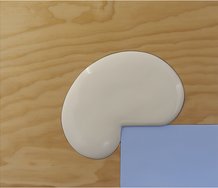

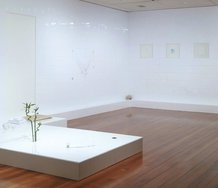
This Discussion has 4 comments.
Comment
Roger Boyce, 6:44 p.m. 26 March, 2014 #
"When needs he must, yet faintly then he praises, Somewhat the deed, much more the means he raises:So marreth what he makes, and praising most, dispraises."
John Hurrell, 6:58 p.m. 26 March, 2014 #
Hey Mr. Boyce, where's the democracy here? This is a forum, and if you have differences with Mr. Leslie, keep the conversation centred on Mr. de Vries' work. Elaborate by way of the exhibition particulars, instead of using vaguely ad hominem sneering.
Roger Boyce, 12:31 a.m. 27 March, 2014 #
Hey Mr. Hurrell, I don't see my comment demonstrating, what you've called, "differences with Mr. Leslie" himself. Nor do I accept my initial thread comment (in the form of a quote) supports your speculation re "sneering".
As to notions of "democracy" - as applied to critical parsing of primary (or secondary) cultural artifacts - I'm an admitted longtime convert to critical-elitism. By way of frankly contending communities (or representatives) of accrued familiarity, with artifacts in question.
With my short quote (from Phineas Fletcher) I was attempting (and apparently failing) to efficiently play the ball (essay) rather than the man.
I'll admit to too much faith in thread-readers' potential for teasing evident (albeit economical) meaning from the Fletcher stanza. And For that you have my unreserved (and now elaborate) apology.
As to your perfectly reasonable invitation to elaborate further on my disagreement with Mr. Leslie's critical attempt on Mr. de Vries' protean works - via "exhibition particulars" - I must, perforce, decline on grounds of general world-weariness and non-specified other-priorities.
My demurral also rests with and resists the demoralizing phenomena one often encounters when explaining either poetry or punchline - a common experience of both explainer and listener. All wit and enjoyment is irretrievably drained in the exercise of explaining verse or humor.
Suffice it to say I took Fletcher's partial stanza as scientifically-elegant comment on the still common practice of 'damning with faint praise'.
I would - if I had surplus time and energy - be more specific about what I see as the vague conditions and operations of Mr. Leslie's attempt at written exegesis - unfortunately there's precious little specific, or particular, about it.
Thus my implication ( via Fletcher's verse fragment) that Leslie's critical essay was 'damning with faint praise'.
Which, now that I think more on it, may have been, on my part, overestimation of the writer's intent.
As I conclude this overlong rejoinder I realize just how sorry I've become, for bothering to read Mr. Leslie's piece on Mr. deVries' paintings. Paintings I particularly appreciate. But not as sorry as I am for having ventured to comment at all. It is a fatal character flaw of mine.
I will think twice before venturing to do either again.
Michael Collins, 1:37 p.m. 27 April, 2014 #
The scaling up process was one of many engaging aspects about "Copy Card." I enjoyed the the front to back painting of the characters like Koko (black lines first, then colour over top). This along with the transparency introduced in two paintings with clear plastic supports could also be 'seen through' to the stretcher grid. There is then a considered (and playful) reversal to viewing the painting...well done Tjalling. MC
Participate
Register to Participate.
Sign in
Sign in to an existing account.